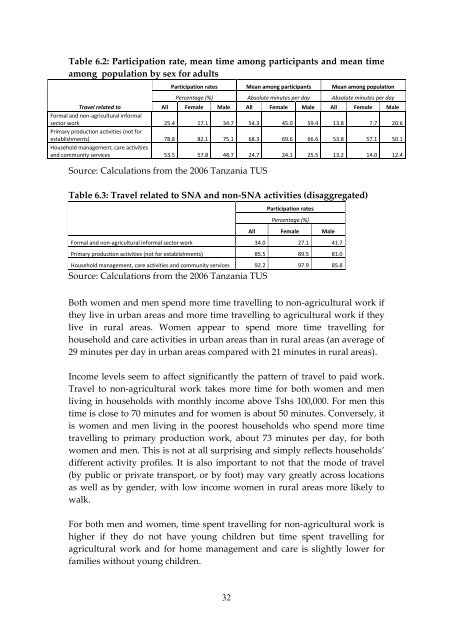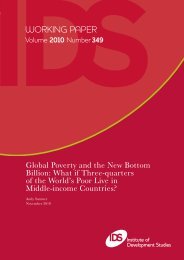Patterns of time use in Tanzania: how to make public investment in ...
Patterns of time use in Tanzania: how to make public investment in ...
Patterns of time use in Tanzania: how to make public investment in ...
You also want an ePaper? Increase the reach of your titles
YUMPU automatically turns print PDFs into web optimized ePapers that Google loves.
Table 6.2: Participation rate, mean <strong>time</strong> among participants and mean <strong>time</strong><br />
among population by sex for adults<br />
Participation rates Mean among participants Mean among population<br />
Percentage (%) Absolute m<strong>in</strong>utes per day Absolute m<strong>in</strong>utes per day<br />
Travel related <strong>to</strong><br />
Formal and non-agricultural <strong>in</strong>formal<br />
All Female Male All Female Male All Female Male<br />
sec<strong>to</strong>r work<br />
Primary production activities (not for<br />
25.4 17.1 34.7 54.3 45.0 59.4 13.8 7.7 20.6<br />
establishments)<br />
Ho<strong>use</strong>hold management, care activities<br />
78.8 82.1 75.1 68.3 69.6 66.6 53.8 57.1 50.1<br />
and community services 53.5 57.8 48.7 24.7 24.1 25.5 13.2 14.0 12.4<br />
Source: Calculations from the 2006 <strong>Tanzania</strong> TUS<br />
Table 6.3: Travel related <strong>to</strong> SNA and non-SNA activities (disaggregated)<br />
32<br />
Participation rates<br />
Percentage (%)<br />
All Female Male<br />
Formal and non-agricultural <strong>in</strong>formal sec<strong>to</strong>r work 34.0 27.1 41.7<br />
Primary production activities (not for establishments) 85.5 89.5 81.0<br />
Ho<strong>use</strong>hold management, care activities and community services 92.2 97.9 85.8<br />
Source: Calculations from the 2006 <strong>Tanzania</strong> TUS<br />
Both women and men spend more <strong>time</strong> travell<strong>in</strong>g <strong>to</strong> non-agricultural work if<br />
they live <strong>in</strong> urban areas and more <strong>time</strong> travell<strong>in</strong>g <strong>to</strong> agricultural work if they<br />
live <strong>in</strong> rural areas. Women appear <strong>to</strong> spend more <strong>time</strong> travell<strong>in</strong>g for<br />
ho<strong>use</strong>hold and care activities <strong>in</strong> urban areas than <strong>in</strong> rural areas (an average <strong>of</strong><br />
29 m<strong>in</strong>utes per day <strong>in</strong> urban areas compared with 21 m<strong>in</strong>utes <strong>in</strong> rural areas).<br />
Income levels seem <strong>to</strong> affect significantly the pattern <strong>of</strong> travel <strong>to</strong> paid work.<br />
Travel <strong>to</strong> non-agricultural work takes more <strong>time</strong> for both women and men<br />
liv<strong>in</strong>g <strong>in</strong> ho<strong>use</strong>holds with monthly <strong>in</strong>come above Tshs 100,000. For men this<br />
<strong>time</strong> is close <strong>to</strong> 70 m<strong>in</strong>utes and for women is about 50 m<strong>in</strong>utes. Conversely, it<br />
is women and men liv<strong>in</strong>g <strong>in</strong> the poorest ho<strong>use</strong>holds who spend more <strong>time</strong><br />
travell<strong>in</strong>g <strong>to</strong> primary production work, about 73 m<strong>in</strong>utes per day, for both<br />
women and men. This is not at all surpris<strong>in</strong>g and simply reflects ho<strong>use</strong>holds’<br />
different activity pr<strong>of</strong>iles. It is also important <strong>to</strong> not that the mode <strong>of</strong> travel<br />
(by <strong>public</strong> or private transport, or by foot) may vary greatly across locations<br />
as well as by gender, with low <strong>in</strong>come women <strong>in</strong> rural areas more likely <strong>to</strong><br />
walk.<br />
For both men and women, <strong>time</strong> spent travell<strong>in</strong>g for non-agricultural work is<br />
higher if they do not have young children but <strong>time</strong> spent travell<strong>in</strong>g for<br />
agricultural work and for home management and care is slightly lower for<br />
families without young children.

















